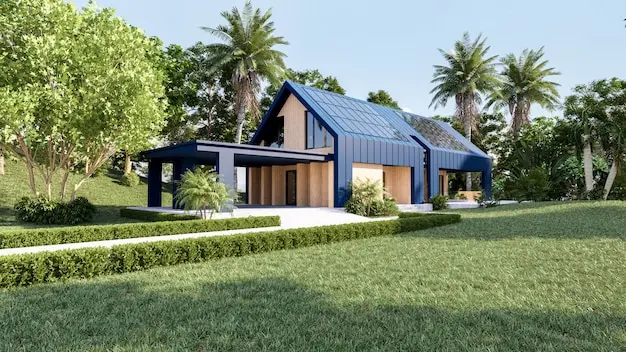In the era of eco-consciousness, the choices we make about where we live and how we live can have a profound impact on our planet. For newly married couples, new homeowners, younger generations, and environmental enthusiasts, sustainable living has become not just a lifestyle, but a responsibility. This notion is especially true when we consider the footprint of our homes.
Our residences have traditionally been a significant source of carbon emissions, excessive water usage, and waste. However, by embracing the concepts of sustainable housing, or eco-friendly housing, we can transform our homes into models of efficiency and environmental stewardship. These greenhouses, built on the principles of sustainable architecture, are not just beneficial to the environment but also offer tangible benefits for their residents, such as healthier indoor environments and lower energy costs.
In this blog post, we’ll explore how sustainable housing can positively influence the environment, delving into various aspects such as energy conservation, water efficiency, sustainable building materials, and much more. Whether you’re a new homeowner or an advocate for environmental conservation, this comprehensive guide will serve as your roadmap toward understanding and implementing sustainable living practices at home. Let’s take a step towards a more sustainable and eco-friendly future together.
Key Takeaways
- Sustainable housing incorporates principles of energy conservation, efficient water management, and the use of eco-friendly building materials to reduce environmental impact.
- Through the use of renewable energy sources and energy-efficient technologies, sustainable homes can significantly lower energy consumption and contribute to greenhouse gas reduction.
- Efficient water use and waste management practices in sustainable homes can lead to significant conservation of valuable resources.
- Sustainable housing plays a vital role in building resilient cities by reducing carbon footprint and fostering carbon offsetting practices.
- Besides the environmental benefits, sustainable housing promotes a healthier indoor environment and can lead to cost savings in the long run.
- By adopting sustainable living practices at home, individuals can contribute to ecosystem conservation and become active stewards of the environment.
What is Sustainable Housing?
The term “sustainable housing” refers to homes designed to have a minimal environmental impact while providing a safe and comfortable living space for their residents.
Definition of Eco-friendly Housing and Green Housing
Eco-friendly housing and green housing are interchangeable terms with sustainable housing. They refer to homes designed and constructed in an environmentally responsible and resource-efficient manner. This includes everything from the choice of building site to the design, construction, operation, maintenance, renovation, and finally, deconstruction.
Exploring the Principles of Sustainable Architecture
Sustainable architecture is the backbone of green housing. It employs strategies to reduce the ecological impact of the building through energy efficiency, the use of sustainable materials, and the design of spaces that improve the quality of life for its inhabitants. This can include features such as renewable energy installations, water-efficient appliances, and designs that maximize natural light to reduce energy usage.
The Ecological Impact of Sustainable Housing
Sustainable housing can have significant positive effects on our environment, reducing our carbon footprint and contributing to environmental conservation.
Environmental Conservation through Sustainable Development
One of the critical goals of sustainable housing is to promote sustainable development, reducing our impact on the environment while still meeting our needs. By using sustainable building materials, incorporating energy-efficient technologies, and minimizing waste generation, green homes can play a significant role in preserving our natural resources.
How Sustainable Housing Promotes Eco-consciousness
Sustainable housing is also an effective way to raise awareness about environmental issues. By living in a home that emphasizes sustainability, residents become more conscious of their energy use, water consumption, and waste generation. This awareness can encourage more environmentally friendly behaviors, helping to further reduce our ecological impact.
The Role of Energy Conservation in Sustainable Housing
Energy conservation lies at the heart of sustainable housing. By designing and implementing practices that save energy, we can greatly reduce our homes’ ecological footprint.
Embracing Sustainable Energy Use and Renewable Energy
Eco-friendly homes aim to lower energy consumption and depend less on non-renewable power sources. Sustainable energy use involves using less electricity for heating, cooling, and appliances. It might involve, for example, insulating a home better to reduce the need for artificial heating and cooling. The use of renewable energy sources, such as solar or wind power, can also greatly decrease a home’s carbon footprint.
The Place of Energy-Efficient Technologies in Sustainable Housing
Energy-efficient technologies like LED lighting, high-efficiency appliances, and programmable thermostats can reduce the amount of energy a home consumes. Sustainable housing often includes these technologies, further enhancing energy conservation efforts.
Water Efficiency and Sustainable Water Management in Sustainable Housing
Water conservation is another critical aspect of sustainable housing. Efficient water use can conserve valuable water resources and reduce the strain on municipal water supplies.
Water-Saving Practices in Eco-friendly Housing
Water-saving practices in sustainable housing might include installing low-flow fixtures, collecting rainwater for landscaping purposes, and implementing greywater recycling systems. By adopting these practices, homeowners can significantly reduce their water consumption.
The Importance of Water Resource Preservation
Preserving water resources is vital for the health of our planet. By reducing our water usage and preventing unnecessary water waste, we can contribute to the preservation of these crucial resources and mitigate the effects of water scarcity.
Sustainable Building Materials and Their Importance
Choosing sustainable building materials is a significant part of constructing an eco-friendly home. These materials reduce the environmental impact of construction and can often improve a home’s energy efficiency.
Overview of Green Construction Materials
Green construction materials can include anything from recycled steel to bamboo, cork, reclaimed wood, and even recycled plastic. These materials often require less energy to produce than traditional building materials and can help reduce a home’s overall environmental impact.
How They Contribute to a Healthy Indoor Environment
Sustainable building materials can also create a healthier indoor environment. They often contain fewer volatile organic compounds (VOCs) and other harmful chemicals than traditional materials. This can improve indoor air quality and reduce the risk of health problems related to indoor air pollution.
Air Pollution Control and Sustainable Housing
Sustainable housing designs often include features that help control air pollution, both inside and outside the home.
The Role of Ventilation Systems in Indoor Pollutant Reduction
Proper ventilation systems can help reduce indoor pollutants, such as dust, mold spores, and other allergens. In addition, ventilation systems in eco-friendly homes are often designed to improve energy efficiency, reducing the need for air conditioning and lowering energy consumption.
Integrating Clean Energy Sources for Air Pollution Control
By using clean, renewable energy sources like solar or wind power, sustainable homes can reduce the amount of air pollution produced by residential energy use. Moreover, using electric appliances instead of gas-powered ones can further reduce a home’s contribution to air pollution.
Alternative Energy and its Role in Sustainable Housing
As we move towards a greener future, the integration of alternative energy sources into our homes has become increasingly important.
Sustainable Power and Renewable Power Generation in Housing
Utilizing sustainable power from renewable energy sources like solar, wind, or geothermal energy is a key component of eco-friendly housing. Renewable power generation systems can often be integrated into the design of a new home, or existing homes can be retrofitted to accommodate these systems.
Promoting Recycling and Waste Management in Sustainable Housing
In addition to energy conservation, sustainable housing also promotes efficient waste management. This includes practices such as composting, recycling, and the use of products made from recycled or renewable materials.
Minimizing Waste Generation through Sustainable Practices
In our quest to live more sustainably, minimizing waste is a critical component. Sustainable housing design often incorporates systems and practices that help to reduce the amount of waste generated.
Sustainable Waste Practices and Their Impact on Housing
The use of durable materials in construction, for example, reduces the need for frequent repairs and replacements. Additionally, implementing composting and recycling systems in the home can significantly reduce the amount of household waste that ends up in landfills.
Adopting Sustainable Energy Solutions in Housing
Homes designed with sustainable energy solutions not only reduce waste but also contribute to the overall energy efficiency of the home. This can involve integrating energy-efficient appliances and systems and using renewable energy sources for power generation.
How Sustainable Housing Contributes to the Emergence of Resilient Cities
Green homes don’t just benefit their residents—they can also play a significant role in creating more resilient cities.
Greenhouse Gas Reduction and Low-Carbon Footprint Practices in Housing
By reducing energy consumption and relying on renewable energy sources, sustainable homes contribute significantly to the reduction of greenhouse gas emissions. In addition, practices such as recycling, composting, and using sustainable construction materials can also help to create a lower-carbon footprint.
The Role of Carbon Offsetting in Building Resilient Cities
Carbon offsetting is another strategy that can be incorporated into sustainable housing. This can involve investing in renewable energy projects or initiatives aimed at reducing greenhouse gas emissions. Through these practices, we can counterbalance the carbon emissions produced by our homes and contribute to the building of resilient, sustainable cities.
The Impact of Sustainable Housing on Ecosystem Conservation
Sustainable housing does more than reduce carbon footprint and save resources; it also plays a vital role in conserving the ecosystem and promoting biodiversity.
The Role of Sustainable Housing in Wildlife Protection and Habitat Preservation
Eco-friendly housing minimizes land use and respects the natural habitat during construction, helping to protect local wildlife. Moreover, incorporating green spaces and native plants into landscaping can create a haven for local flora and fauna, contributing to habitat preservation and biodiversity.
Encouraging Natural Resource Stewardship through Sustainable Housing
Sustainable housing promotes the responsible use and conservation of natural resources. Through practices like using sustainable building materials, reducing waste, and conserving energy and water, homeowners can become active stewards of their environment.
Conclusion
The impact of sustainable housing on the environment cannot be overstated. By embracing principles such as energy and water efficiency, the use of sustainable materials, and the integration of renewable energy, we can create homes that are not only comfortable and healthy but also have a significantly reduced environmental footprint.
As more people adopt sustainable living practices, the potential for sustainable housing to transform our cities and help combat climate change is immense. By making thoughtful choices about how we design, build, and live in our homes, we can all contribute to a more sustainable and resilient future.
Whether you are a newlywed, a new homeowner, or a younger-generation environmentalist, the power to make a difference is in your hands. Remember, each small step towards sustainability can have a profound impact on our planet and future generations. Let’s continue to embrace sustainable living and work together to create a greener, healthier world.
Frequently Asked Questions (FAQs)
-
What is sustainable housing?
Sustainable housing refers to homes designed to have a minimal environmental impact, utilizing eco-friendly building materials, energy-efficient technologies, and sustainable water and waste management practices.
-
What are some key principles of sustainable architecture?
Sustainable architecture focuses on reducing environmental impact through energy efficiency, the use of sustainable materials, and the design of spaces that improve inhabitants’ quality of life.
-
How does sustainable housing contribute to energy conservation?
Sustainable housing reduces energy consumption through the use of energy-efficient appliances and systems, as well as the integration of renewable energy sources like solar or wind power.
-
What is the role of sustainable housing in water conservation?
Sustainable housing promotes efficient water use through practices like installing low-flow fixtures, rainwater collection for landscaping, and greywater recycling systems.
-
How does sustainable housing contribute to the emergence of resilient cities?
By reducing greenhouse gas emissions, minimizing waste, and utilizing carbon offsetting, sustainable housing can contribute to building resilient cities that are better prepared for the impacts of climate change.

